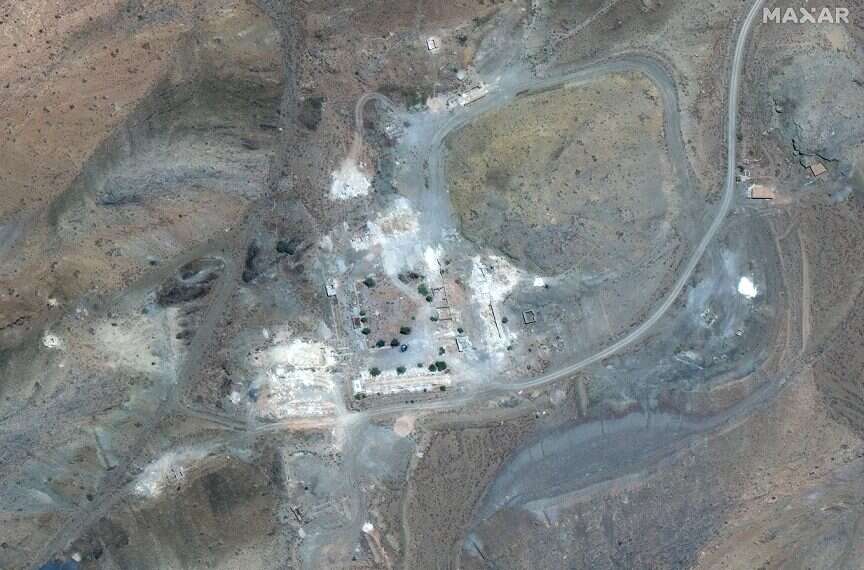by Yoav Limor
If the Israeli Air Force is indeed behind the recent attacks on the Syrian-Iraqi border, it means Israel is prepared to go, and fly, farther than before to enforce its red lines against Iranian entrenchment in Syria or to prevent Hezbollah from acquiring advanced weapons.

This
satellite image shows an area near Abadeh, Iran, that PM Netanyahu on
Monday alleged was a site where Iran conducted nuclear tests | Photo:
Satellite image ©2019 Maxar Technologies via AP
Exactly one week ago, an anonymous source leaked to Fox News that Iran is building a large military base on the Syrian-Iraqi border for its proxy Shiite militias.
The information was detailed and included satellite images and other specifics. It was impossible to view the leak as anything but a clear warning that if the activity at the base continued, it wouldn't be for long. Iran, it appears, didn't take the warning seriously, and on Monday the hammer fell: An overnight attack, destroying the base's infrastructure and killed several 18 people there (the casualty reports have varied), including Iranians.
The previous attack was carried out from the eastern, Iraqi, side, of the border (Al-Qa'im). The attack early Tuesday, meanwhile, came from the western, Syrian, side (Albukamal). The Assad regime allowed Iran to build the base on Syrian soil, supposedly to help him quell what remains of the Islamic State insurgency in the area. In actuality, Iran wants to control the border crossing between Syria and Iraq, which among other things would help it send weapons to Hezbollah in Lebanon.
Iran's activities in this sector have intensified in recent months, as a result of the attacks attributed to Israel in Syria. After Iran's air route for transferring weapons was almost completely shut down, Tehran transitioned to the land route – long and cumbersome but perceived as relatively secure because of the farther distance Israeli aircraft need to fly.
If the Israeli Air Force is indeed behind the latest attacks, it means that Israel is ready to go (or fly, to be more precise) very far to enforce its red lines and prevent Iranian entrenchment in Syria or Hezbollah from acquiring advanced weapons. Assuming this is the case, such operations present a considerable challenge. In terms of intelligence, precise, real-time information is required before a military strike can even be planned. On the operational level, the pilots need to fly a long time in tough conditions, requiring meticulous preparation and perfect execution to ensure the target is destroyed while the jets are exposed to the bare minimum of risks.
The Iranian response, even if it was expected, came quicker than expected. In the past, it took a deep breath before responding and tried carrying out quality reprisal attacks hoping it could evade Israeli defenses and inflict heavy damage. Such was the case in February and May last year and the thwarted drone attack two weeks ago. On Monday, on the other hand, Iran acted hastily: A few hours after the strike on the Syrian-Iraqi border, rockets were fired at Mount Hermon in Israel.
The Imam Hussein Division was responsible for the rocket fire. In recent years it has operated under Iranian direction in Syria and was behind the attempted drone attack reportedly foiled by Israel. It wasn't the first time Iran fired rockets at Israel. That was in May 2018, and then in January, it launched a large rocket at Mount Hermon, which was intercepted. This time, too, the rocket attack failed, indicating poor operational capabilities that were only exacerbated by the hasty execution. It wouldn't be wise to assume this will always be the result. The Quds Force has an impressive ability to learn from its mistakes and will look to improve the performance of the militias under its control, as soon as possible, to exact a price from Israel for the series of embarrassments it has suffered on all fronts – from Iran to Iraq, Syria, and Lebanon.
Israel, therefore, needs to be on high alert defensively, and of course, it must continue to enforce its red lines offensively. One of these lines, declared last week, pertains to Hezbollah's precision missile factory in the Beqaa Valley, which it built with Iranian help. If Monday's incident can serve as any sort of precedent, it's very possible that the warning message delivered to Lebanon will soon be acted upon as well.
The military pressure on Iran was buttressed on Monday by diplomatic pressure with the revelation of another secret nuclear site in Iran. The revelation was less dramatic than the exposure of the Iranian nuclear archive last year, but the fact that it came on the eve of the International Atomic Energy Agency's discussion on Iran's lack of cooperation over the previous site exposed by Israel, and ahead of a possible summit between US President Donald Trump and Iranian President Hassan Rouhani, should help ramp up the pressure on Tehran.
Source: https://www.israelhayom.com/2019/09/10/israel-is-prepared-to-go-and-fly-the-distance/
Follow Middle East and Terrorism on Twitter
No comments:
Post a Comment